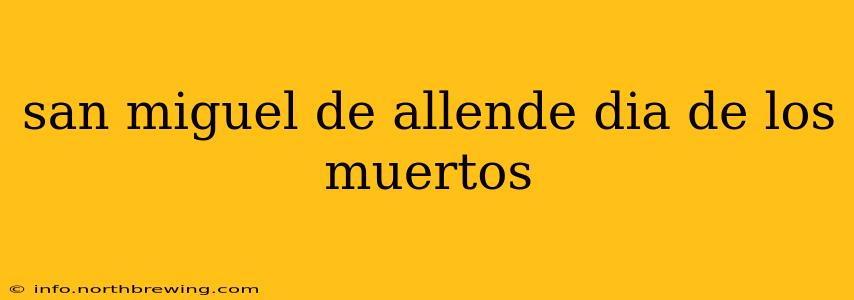Día de Muertos, or Day of the Dead, is a vibrant and deeply moving celebration in Mexico, and San Miguel de Allende offers a particularly captivating experience. This enchanting colonial city transforms during this time, showcasing its rich cultural heritage with stunning altars, processions, and community events that honor the departed. More than just a holiday, it's a powerful testament to the enduring bonds between the living and the dead. This guide delves into the unique aspects of Día de Muertos in San Miguel de Allende, exploring its traditions and offering insights for visitors wishing to participate in this unforgettable cultural spectacle.
What makes San Miguel de Allende's Día de Muertos unique?
San Miguel de Allende's Día de Muertos celebration blends the ancient traditions of indigenous cultures with the influences of Spanish Catholicism, creating a unique and deeply spiritual atmosphere. Unlike some larger cities where celebrations may be more commercialized, San Miguel retains a strong sense of community and authentic tradition. The smaller scale allows for a more intimate and immersive experience, offering visitors a deeper understanding of the holiday's meaning. The city's stunning colonial architecture serves as a breathtaking backdrop to the colorful altars and processions, making it a truly memorable experience.
What are the main events and activities during Día de Muertos in San Miguel de Allende?
The celebrations in San Miguel typically span several days, culminating on November 1st and 2nd. You can expect a variety of events, including:
-
Ofrendas (Altars): Elaborate altars, or ofrendas, are created in homes, businesses, and public spaces. These altars are adorned with photographs of deceased loved ones, their favorite foods and drinks, marigolds (cempasúchil), candles, and other symbolic items. Each element holds significant meaning, reflecting the individual's life and personality. Many are open to the public to view and appreciate.
-
Processions: Witness moving processions winding through the streets, carrying images of saints and deceased loved ones. These processions often include traditional music and are a powerful display of community mourning and remembrance.
-
Cemeteries: Visits to the cemeteries are a significant part of the celebration. Families gather to clean and decorate the graves of their loved ones, sharing stories and memories. The atmosphere is both somber and joyful, a testament to the Mexican perspective on death as a natural part of life's cycle.
-
Food and Drink: Traditional foods like pan de muerto (bread of the dead), calaveras de azúcar (sugar skulls), and mole are abundant during this time. Sharing these foods is a central part of the celebrations, strengthening community bonds and remembering the departed through their favorite dishes.
What is the history of Día de Muertos in San Miguel de Allende?
The origins of Día de Muertos are rooted in the ancient indigenous cultures of Mexico, particularly the Aztec and Nahua traditions. These cultures held complex beliefs about the afterlife, celebrating the return of spirits to the land of the living. The Spanish conquest introduced Catholic influences, blending the existing traditions with the Catholic All Saints' Day and All Souls' Day. This fusion created the unique and syncretic celebration we know today, a beautiful blend of indigenous spirituality and Catholic rituals. In San Miguel, this history is palpable, with traditions passed down through generations, maintaining the authenticity of the celebration.
Where are the best places to see the ofrendas in San Miguel de Allende?
The best places to see the ofrendas are often in the historic center, where many homes and businesses create elaborate displays. Many public spaces also host community altars. It's recommended to wander through the streets, exploring the various neighborhoods and discovering these beautiful and moving tributes to the deceased. Look for areas around El Jardín (the main square), and also explore the quieter streets leading off from the main thoroughfares.
What should I wear to a Día de Muertos celebration in San Miguel de Allende?
While there's no strict dress code, many people choose to wear clothing that reflects the vibrant colors and themes of the celebration. Consider incorporating traditional Mexican elements such as floral prints, bright colors, or perhaps even a sugar skull design. The most important thing is to be respectful of the cultural significance of the holiday.
Is Día de Muertos in San Miguel de Allende family-friendly?
Yes, Día de Muertos in San Miguel de Allende is generally family-friendly. However, it's important to remember that it's a celebration that revolves around death and remembrance. While the atmosphere is generally festive, some aspects might be more emotionally resonant for children than others. Parental guidance and explanations of the holiday’s significance would be beneficial.
This guide offers a glimpse into the magic of Día de Muertos in San Miguel de Allende. While this article covers the key aspects, the true beauty of the experience lies in immersing yourself in the vibrant atmosphere and experiencing the heartfelt traditions firsthand. It's a journey of remembrance and celebration, a powerful tribute to the enduring bond between the living and the departed, uniquely expressed in the heart of this captivating colonial city.
